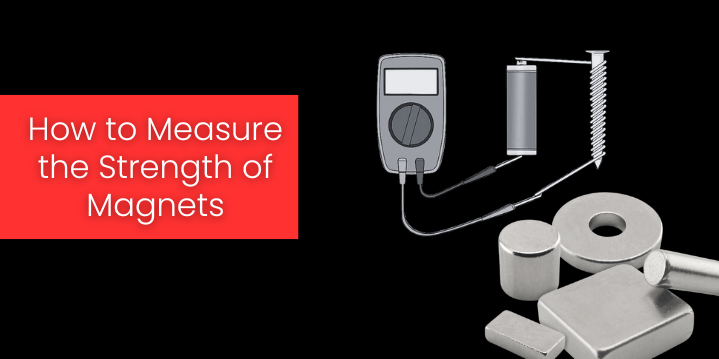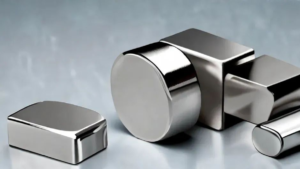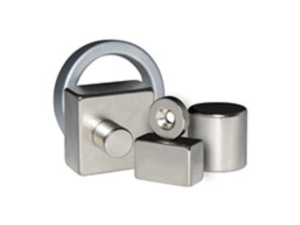

Magnets are as small as 1 mm in diameter with 1 mm thickness—which would be able to attract your hairpins. Or they can be as huge as 80 mm in diameter with 65 mm thickness, enabling them to lift over 300 pounds.
Such is the power of a magnet which varies based on the size and material.
Whether you are using magnets for industrial purposes or in everyday life, it is essential to ensure that their strength is appropriate for the intended application.
Testing magnet strength is, therefore, a crucial step in the quality control process.
Here we will walk through various methods to test magnet strength.
Before we delve into the testing methods, let us first understand what magnet strength means. The strength of a magnet refers to its ability to attract or repel ferromagnetic materials.
Magnetic flux density or magnetic field strength are the common units of measurement. The Tesla (T) is used to measure magnetic field strength, while the Gauss (G) is used to measure magnetic flux density.
Now let’s look at some of the methods to test magnet strength:
One of the simplest and most commonly used methods to test magnet strength is to use a magnetic field strength meter.
To use a magnetic field strength meter, simply place the meter close to the surface of the magnet and record the readings. However, this method only measures the magnetic field strength on the surface of the magnet and does not provide information about the strength inside the magnet.
A Gauss meter is a more advanced instrument that measures magnetic flux density. It can provide more accurate results than a magnetic field strength meter. Gauss meters can measure the magnetic flux density at different points on the surface of the magnet, as well as inside the magnet.
This method is commonly used to test magnets with intricate shapes or structures.
Placing the Gaussmeter sensor close to the magnet will allow you to measure the strength of the magnetic field it produces. The magnetic field strength will be shown by the Gaussmeter in either Gauss or Tesla units. This approach is perfect for determining the strength of small magnets because it is straightforward to use.
However, this method has its limitations.
Gaussmeters can only measure the magnetic field strength at a specific point in space. They cannot measure the magnetic field strength over a large area or volume. Moreover, the Gaussmeter can be affected by external magnetic fields, which can interfere with the measurement.
A fluxmeter is another advanced instrument that measures magnetic flux density.
It ensures more accuracy than a Gaussmeter as well as provides more detailed information associated with the magnetic field. It measures the magnetic flux traveling through a surface.
It is particularly useful for testing magnets that have a specific shape or size.
A vibrating sample magnetometer is a laboratory instrument that measures the magnetic properties of materials. It is a more advanced and accurate method to test magnet strength. The VSM measures the magnetic moment of a sample by applying a magnetic field and measuring the response of the sample. This method provides detailed information about the magnetization of the sample, including its hysteresis loop, magnetic anisotropy, and coercivity.
A pull-off test is a simple and effective method to test the adhesive strength of a magnet. This method works by pulling the magnet off a surface to which it is attached.
It is particularly useful for testing the strength of magnets used in industrial applications where the magnet is attached to a surface using an adhesive.
MFM is a microscopy technique that is used to image magnetic fields. It is a more advanced method to test magnet strength and provides high-resolution images of the magnetic field distribution.
MFM works by scanning a small magnetic probe over the surface of the magnet and measuring the magnetic field. This method is particularly useful for testing the strength of magnets used in nanotechnology and other high-tech applications.
The principle of MFM is similar to that of Atomic Force Microscopy (AFM), a widely used technique in materials science and nanotechnology.
MFM is particularly useful for studying magnetic materials at the nanoscale, where the magnetic properties can vary significantly depending on the size and shape of the sample. For example, MFM can be used to investigate the magnetic behavior of magnetic nanoparticles, which are important for applications such as magnetic data storage, magnetic hyperthermia, and magnetic resonance imaging.
MFM is also valuable for testing the strength of magnets used in high-tech applications. By measuring the magnetic field distribution of a magnet, it is possible to determine its magnetic moment and coercivity, which are important parameters for evaluating the performance of magnetic materials. MFM can also detect defects or irregularities in the magnet, which can affect its magnetic properties and performance.
A Hall effect sensor is another device used to measure the magnetic field strength of a magnet. It works by detecting the voltage generated by the magnetic field of the magnet. The key components of the Hall effect sensor are a thin semiconductor sheet and a magnetic substance.
Place the Hall effect sensor close to the magnet to detect the magnet’s magnetic field strength. The magnet’s magnetic field intensity will cause the Hall effect sensor to produce a voltage that is proportionate to it. This voltage can be measured and transformed into a numerical representation of the strength of the magnetic field.
This method is more accurate than the Gaussmeter method as it can measure the magnetic field strength over a larger area. However, it is more complex and expensive than the Gaussmeter method.
There are various methods available to test magnet strength, ranging from simple and portable instruments to more advanced laboratory techniques.
The choice of method depends on the specific application and the level of accuracy required. The magnetic field strength meter and Gauss meter are the most commonly used methods for testing magnet strength, while the vibrating sample magnetometer and magnetic force microscopy provide more detailed information about the magnetic properties of the material.
Hope you must have understood the methods to test the strength of your magnet. Go ahead and pick the one to experience the strength of your magnet. Happy reading!

Magnetic sheeting is a flexible material that can be magnetized on one side and often has an adhesive or printable surface on the other. It

Magnets come in various shapes and sizes, each designed for specific uses. Understanding the different shapes of magnets, their properties, and their applications can help

Magnets are a fascinating part of our everyday lives, from the magnets on our fridge doors to the powerful magnets used in advanced technology. There
Our magnet experts will help you get exactly what you need – custom or stock – in record time with great quality at a very competitive price.
Ⓒ 2024 - All Rights Are Reserved